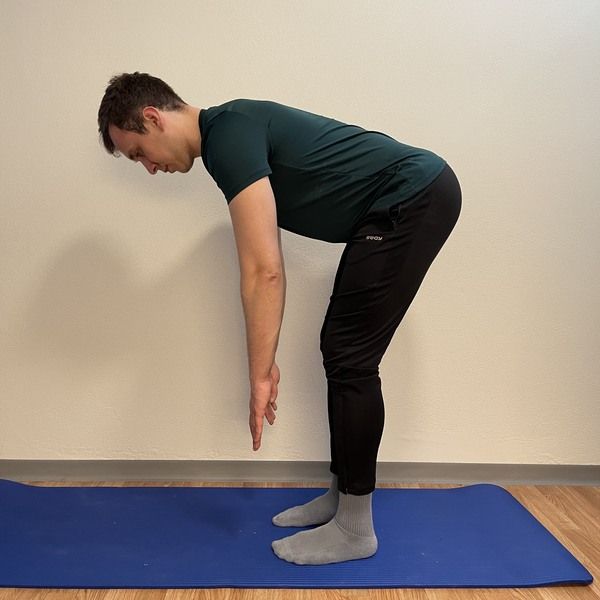What Does Touching Your Toes Stretch – Muscles and Joints
Although touching your toes from standing seems easy and straightforward, this exercise requires good mobility of the joints and flexibility of the muscles of the upper and lower part of the body. To touch your toes from standing, you should do stretches for specific muscle groups.
So, what does touching your toes stretch exactly?
When you touch your toes from standing or sitting, you stretch primary lower back extensors, glutes, hamstrings and calf muscles. Additionally, you put a gentle stretch on your middle and upper back extensors, muscles between your shoulder blades, lats and plantar fascia.
Here is the list of muscles you’re stretching when you reach toward your toes from standing (sorted by body segment).
Bonus: Stretching books and stretching ebook that help you learn easily muscle anatomy and stretching exercises and 5 Benefits of Touching Your Toes.

Standing Touch your toes exercise
Primary Muscles That Touching Your Toes Stretch
- Back extensors (erector spinae muscle group including m. iliocostalis, m.spinalis and m. longissimus)
- Glutes (gluteus maximus mostly)
- Hamstrings (biceps femoris, semitendinosus, semimembranosus)
Erector spinae muscles are back muscles that run along your spine from the lower back (sacrum) and go all the way to the bones of the skull.
They consist of several muscles (listed above) that participate in back extension and lateral bending movements (when one side of these muscles is activated/also known as unilateral muscle contraction).
Every forward bending of the trunk will result in stretching of erector spinae muscles. Touching your toes from standing is mainly torso flexion and targets mainly these muscles.
Gluteus maximus is the main hip extensor, while the gluteus medius and minimus help with hip abduction. (legs move to the side)
When you try to touch your toes, you bring the hips into increased flexion (the hips move closer to the trunk), which increases the stretch in the gluteus maximus.
Hamstrings are back thigh muscles and consist of three different muscles. Semitendinosus and semimembranosus are medially (inner part), and biceps femoris is lateral. (outer part)
Shortness in the hamstring muscles is the most common cause of people not being able to touch their toes. If you have experienced too much tension behind your knee, then your biceps femoris muscle is most probably too short/inflexible.
Secondary Muscles That Touching Your Toes Stretch
- Middle back and neck extensors
- Shoulder blade muscles
- Lats
- Plantar fascia
In order to touch your toes from standing, you have to round your shoulders forward and thus bend the thoracic spine.
These movements lead to a gentle stretching of neck and thoracic extensors and muscles between your shoulder blades (m. rhomboideus).
Lats are muscles that pull your arm backward, adduct and rotate it inward. When you extend your arms forward as you try to touch your heels, lats are relaxed and stretch gently with the help of gravity.
Plantar fascia is actually the connective tissue that connects your heel with the bases of your toes. You will very rarely feel a stretch in your foot when you practice touching your heel from a standing position, but I want you to understand that this movement actually stretches this part of the body as well.
Although the plantar fascia is actually a small area, we all rely on it every day when walking. Therefore I find it useful to mention it here, even though fascia is not a muscle.
Mobility of Joints When You Touch Your Toes From Standing
Here is what happens with your joints when you perform touch your toes from standing:
- Posterior pelvic tilt
- Lumbar flexion
- Holding knee extension
The first thing you should do is rotate your pelvis backward. This movement is otherwise called posterior pelvic tilt.
Then, as your body lowers down, you should bend your lumbar spine forward/lumbar flexion.
The knees are in extension so the stretch in the hamstrings is getting stronger and stronger.
Then you reach your toes from standing. Good job!
What to do if You Can’t Touch Your Toes From Standing
If you can’t touch your toes while standing, pay attention to the part of your body where you feel the most tension when performing this movement.
Do you have tight hamstrings? Or does the lower back just don’t want to bend forward?
When you determine the exact problem, then you can move on to stretching and mobility exercises for the exact muscle or part of the body.
Here is one challenge I created to help you achieve your stretching goal. Follow this program and touch your toes in just 7 days. Included stretches to touch toes after only one week of daily stretching.
Good luck and share your experience in the comments below.
Learn more about stretching anatomy and muscle function by reading books on stretching and flexibility.
